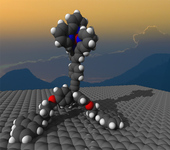Highlight
Molecular Tripods Add Functionality to Graphene Surfaces
Achievement/Results
Working with a team of interdisciplinary scientists at Cornell University, IGERT Fellow Jason Mann has developed a new type of molecule that uses three “sticky feet” to add chemical functionality to single-atom-thick sheets of carbon without breaking any bonds.
The remarkable electronic and mechanical properties of single-atom-thick layers of graphite — so-called “graphene” sheets — make this material ideal for many applications, including inexpensive transparent electrodes, transistors, strain sensors, and chemical barriers. Nevertheless, the uniform two-dimensional structure of graphene is devoid of chemical “handles” that would enable the attachment of additional chemical or biological functionality – functionality that might enable new types of chemical or biological sensors, for example. While such handles can be attached covalently, this type of attachment would destroy the unique electronic properties of graphene and potentially degrade its mechanical properties.
Taking a new approach to graphene functionalization, IGERT Fellow Jason Mann designed modular tripodal molecules with “feet” that stick to graphene without disrupting its bonding network. The first generation of molecules included an electroactive metal center. Working in collaboration with IGERT Fellows Cen Tan and Nicole Ritzert, Mann and coworkers used electrochemical techniques to show that the molecules had a high affinity for graphene. To prove that the tripodal structure was the key to success, the group compared the binding of molecular tripods to structurally similar molecular monopods. As anticipated, the monopods detached from the surface 1000 times more quickly than the tripods.
The modular synthetic approach enables the attachment of different chemical “heads” to the three molecular feet. The team anticipates using appropriately functionalized tripods as anchors for interfacing polymers or extended materials to the graphene surface. Future generations of tripods will not only provide a more reproducible platform for single molecule conductance measurements but will also allow construction of molecularly well-defined electronic devices ranging from molecular memory devices to solar cells.
*Mann, J. A., Rodriguez-Lopez, J., Abruna, H. D. & Dichtel, W. D. (2011). Multivalent Binding Motifs for the Noncovalent Functionalization of Graphene. Journal of the American Chemical Society, 133, 17614-17617.
Rodriguez-Lopez, J., *Ritzert, N. L., *Mann, J. A., *Tan, C., Dichtel, W. D., & Abruna, H. D. (2012). Quantification of the Surface Diffusion of Tripodal Binding Motifs on Graphene Using Scanning Electrochemical Microscopy. Journal of the American Chemical Society. DOI: 10.1021/ja106724.
Address Goals
Discovery: The development of new approaches for the chemical functionalization of single-atom-thick graphene sheets will enable the addition of chemical and biological functionality to this remarkable material. These modular molecules will potentially enable fundamental and technological advances in fields as diverse as molecular electronics, organic photovoltaics, and chemical sensing.
Learning: This highly interdisciplinary and integrative research project required the sustained contributions of scientists with a wide range of talents and expertise. This interdisciplinary milieu provided an ideal training ground for next-generation scientists and engineers educated in cutting-edge nanoscience.






